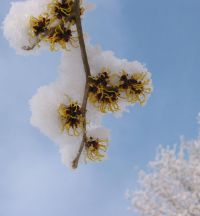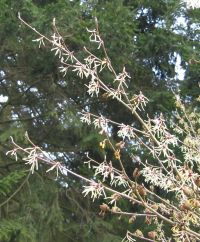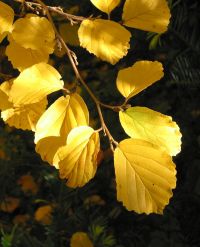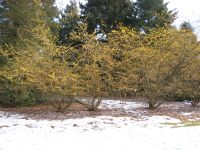Japanese Witch hazel - Hamamalis japonica
English name:
Japanese Witch hazel
Scientific name:
Hamamalis japonica 3a
Family:
Hamamelidaceae (Witch hazel)
Height:
4 M
Flowering:
January to early April
Range:
Japan: N. Honshu, Kyushu, Shikoku
|
|
 |
 |
 |
The three 55 year old Hamamelis japonica in the top picture are from seed produced on a specimen in the Forest Botanic Garden in Charlottenlund. They can be found on the south side of the first grass plain in the Arboretum, in square 1114 and position 3831. A map with squares and positions can be found on our homepage under: Digital plant search of the Arboretum.
Plant description:
This winter has been rather snowy, but still the Hamamelis species within our collection have not failed to impress me like in other winters. This months species, Hamamelis japonica, will be the fourth time I have used a member of this remarkable genus for a Plant of the Month. The others being: Hamamelis virginiana (November 2003), Hamamelis mollis (February 2004) and Hamamelis x intermedia Diana (February 2005). Hamamelis japonica has some climate races (provenances) that flower rather late and specimens are typically seen in flower throughout March and sometimes in to April. Nevertheless the earlier provenances can already flower in January, if it is a warm winter.
Hamamelis japonica is not rare in Japan. It can be up to 10 m tall and 30 cm in diameter. It is reported to be well known to Japanese villagers in part for its remarkably early flowering The branches are also strong and pliable and can be twisted and used for fastening rafts and timbers when building or repairing traditional houses. The species is also planted as an ornamental in Japan where many cultivars no doubt exist.
Hamamelis japonica was first introduced to gardens in the west by Philipp Franz von Siebold in 1863. It is reported to have been offered for sale in a Danish Forest seed company in 1899. In 1907 The Forest Botanic Garden in Charlottenlund (for runner to the Hørsholm Arboretum) received a specimen from the Hesse Nursery, Weener Am Ems, Ostfriesland, Germany. The three largest specimens in the Hørsholm Arboretum are direct descendants of this 1907 accession. Hamamelis japonica will easily hybridize with Hamamelis mollis and it is possible that these oldest plants are hybrids, with characteristics very similar to H. japonica. In total we have 11 examples of the Hamamelis japonica in our collection in Hørsholm. Eight are from seed collected in the wild in Japan. Six of these were collected during the Nordic Arboretum Committee expedition to Japan in 1976.
In Denmark, Hamamelis japonica is a large deciduous shrub or small tree. The twigs are less densely hairy than in H. mollis. The ovate leaves are spaced alternately on the twigs and are generally smaller in comparison with other Hamamelis species. They are hairless to slightly pubescent on the under surface by autumn and possess a wavy margin. Autumn leaf colour is excellent and ranges from bright yellow (see photo) to orange and red. The 4, strap-shaped petals on the flowers are more crinkled and the fragrance is less strong than in Hamamelis mollis. This latter trait can be an advantage if, like me, you find the perfume of H. mollis too overwhelming when brought indoors. The petals often but not always, are red or purple at the base. In our collection the colours of the petals range from strong yellow, yellow with a red base to a rather pale yellow. The woody fruit capsules hold two shiny-black seeds with a light coloured eye at one end. A few seeds could still be seen on our plants on 1 March this year, but most have been shot out of the seed capsule by this time of the year.
Hamamelis japonica can certainly be recommended for the garden. Although it is typically not as showy as H. mollis, the species is quite variable giving good possibilities for fine cultivars. The flowers often create a more delicate, scattered-stars effect in comparison with H. mollis.. Flower size, colour and the timing of flowering varies significantly among the wild collected plants in the Arboretum. For example the flowers on our plants from the Akasawa Forest Reserve in the Nagano Prefecture of central Honshu are very small. Those from the northern, Iwate Prefecture are late flowering and can still be in flower in April. Our examples from Tateyama, Toyama Prefecture are a very pale yellow in colour (see photo). There are a number of cultivars and varieties of this species and several have won awards over the year as especially good garden plants. Hamamelis plants tend to become leggy with age, but denser bushes can be created by regular pruning.
References:
Bean, W.J. 1976 Trees and Shrubs Hardy in the British Isles Vol II. A-C. Bean and Murray publishers. 784 pp.
Houtmen, R. T. & van der Werf, W.J. 2002. Hamamelis sortimentsondersoek en keuringsrapport (A report from the assessment of varieties of Hamamelis). Dendroflora 39: 30-59.
Kurata, S. 1971. Illustrated Important Forest Trees of Japan Vol 3. Chikyu Shuppan Co. Ltd., Tokyo 259 pp.
Lange, J. 1994. Kulturplanternes Indførselshistorie i Danmark. (Introduction History of Cultivated Plants in Denmark). Jordbrugsforlaget, Frederiksberg. 458 pp.
Rushforth, K. 1999. Trees of Britain and Europe. Harper Collins Publisher. 1336 Pp.
Strand, C. 1998. Asian witch hazels and their hybrids: a history of Hamamelis in cultivation. The New Plantsman 5: 231-245.

